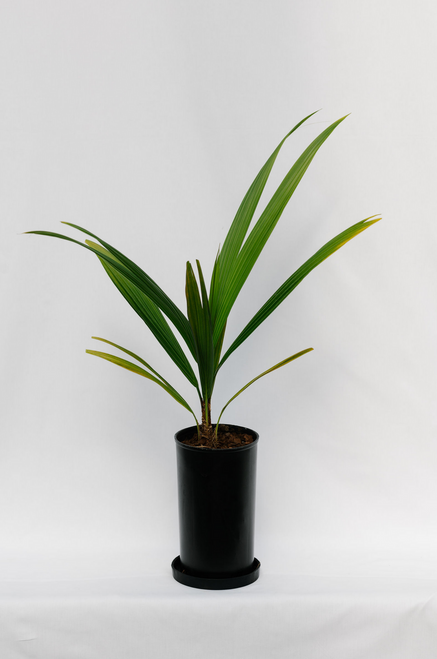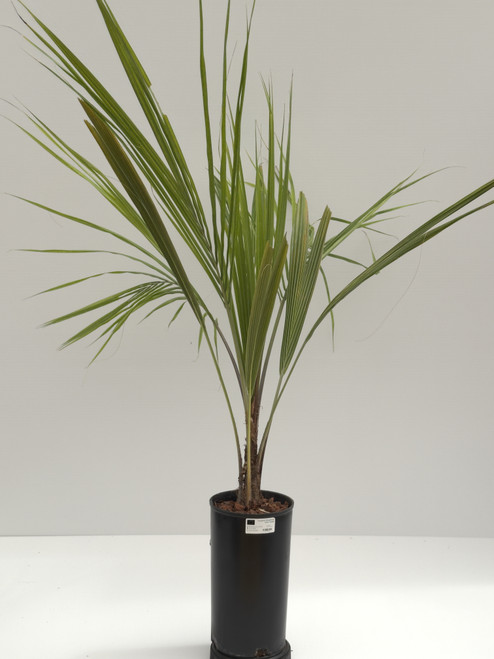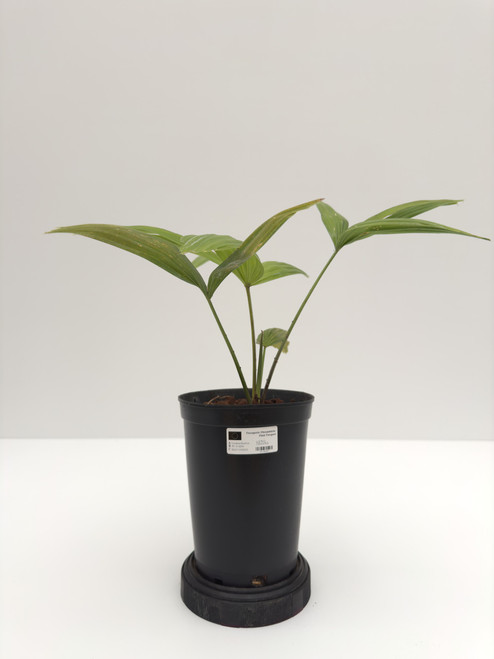Product Description
Habitat and Distribution
Western Australia. In the Hamersley Region mainly in the upper reaches of the Fortescue, Robe and Ashburton Rivers. A small disjunct and apparently senescent population occurs in the Cape Ra., North West Cape Peninsula, on the western side of Exmouth Gulf. Grows adjacent to watercourses and along drainage lines in well-drained sites, 50-560 m alt. (Dowe, J.L.)
Below the Hammersley Ranges along waterways and some pools (including the Millstream Pools, where this palm gets its common name, the Milstream Palm.
Description
Livistona alfredii is a medium sized solitary fan palm growing to about ten metres (30 ft.) or more, in height. The fronds have relatively fine leaflets, and are grey-green to blue-green in colour on stalks about a metre long. After the leaves die, the stalks remain on the upper part of the trunk. The flowers are cream or yellow coloured and are produced in spring and summer from September to January. The fruit are round and about3 cm to 4 cm in diameter, turning dark brown when they ripen. It is not a common palm in cultivation, and is a slow growing species.
Functionally dioecious palm. Trunk to 12 m tall, 20-50 cm in diam. breast high, leaf scars prominent, internodes narrow, pale grey, petiole stubs persistent in basal 1 m, otherwise deciduous. Leaves 25-30 in a globose crown; petiole 90- 130 cm long, 25-30 mm wide, adaxially flat, margins with curved singleblack spines congested in the proximal portion; leaf-base fibres prominent, coarse, persistent; lamina costapalmate, regularly segmented, subcircularin outline, 90-140 cm long, rigid, adaxially pale green-grey to glaucous, waxy, dull; abaxially light green-grey, waxy; lamina divided for 60-70% of its length, with 50-66 segments, depth of apical cleft 60-75% of the segment length, apical lobes attenuate, rigid; parallel veins 6-8 each side of midrib; transverse veins thinner than parallel veins. Inflorescences unbranched at the base, not sexually dimorphic, 80-270 cm long, not extending beyond the limit of the crown, branched to 3 orders; partial inflorescences 5-7; prophyll not seen; peduncular bracts 1-2, loosely sheathing, sparsely to moderately scaly; rachis bracts loosely sheathing, sparsely to moderately scaly; rachillae to 13 cm long, to 2 mm diameter, white pruinose, papillose. Flowers solitary or in pairs, cylindrical in bud; sepals triangular, 0.8-1 mm long, acute, cream to yellowish; petals triangular, 2-3 mm long, acute to mucronate, cream to yellowish; stamens about 2 mm long. Fruit globose, 25-40 mm in diam., dark brown to black; epicarp with scattered lenticellular pores; suture line extends to about ½ way to base; pedicel to 3 mm long. Seed globose, 17-20 mm wide. Eophyll 3-ribbed. (Dowe, J.L.)/Palmweb. Editing by edric.
Specimens relating to L. alfredii were first cited by Mueller (1878) as part of the distribution of L. mariae. The protologue of L. alfredii (Mueller, 1892) was an informal account in Victorian Naturalist. It included some manner of distinguishing it from L. mariae, and discussed leaf colour and fruit size. Mueller named it in honour of Alfred, Duke of Edinburgh. The type, Forrest s.n. is mentioned in the account of L. mariae. Drude (1893) found L. alfredii distinct enough to place it in its own section, Gregorya. Beccari (1921) similarly provided only a meagre description, but in 1931 provided a complete description based on the Forrest and McRae specimens. Livistona alfredii is the most geographically isolated species of Livistona in Australia. Livistona alfredii is a moderate canopy palm to 12 m tall; leaves are large and regularly segmented; segment apices are rigid, and with a bifurcate cleft to 75% of the segment length; the inflorescence is unbranched, not extending beyond the limit of the crown, and with up to 7 partial inflorescences; bracts are loosely sheathing; flowers are cream to yellow; fruit are globose to 40 mm in diam., and dark brown to black at maturity. (Dowe, J.L.)/Palmweb.
Culture
"This palm appears to be relatively rare in cultivation outside of Australia for, at this time, unknown reasons. It is an attractive and easily the hardiest of the blue-green Livistonas (including Livistona victoriae and Livistona loryphylla) in terms of cold and wet tolerance. So far cultivation in southern California seems fairly easy and cold tolerance has not been established, but it is evidently cold tolerant down to 25F without any damage noted. It is a slow growing species taking about 6-8 years to form a trunk from a seedling. It seems to be very drought tolerant and has a very high heat tolerance based on its ease and increased rate of growth in the inland deserts of southern California." (Cultural information by Geoff Stein)
Comments and Curiosities
Etymology: Specific epithet honors the 17th century Baron of Livingston, Patrick Murray, whose plants became the foundation of the Edinburgh Botanic Garden.
Phenology: Flowers Sep-Jan; fruits Dec-May.
Conservation: The population is conserved within Millstream National Park. This palm tree is scattered in dry open forest between 100 and 150 m. Potential threats include fires, natural disasters and tourism. (IUCN Red List 1998)









